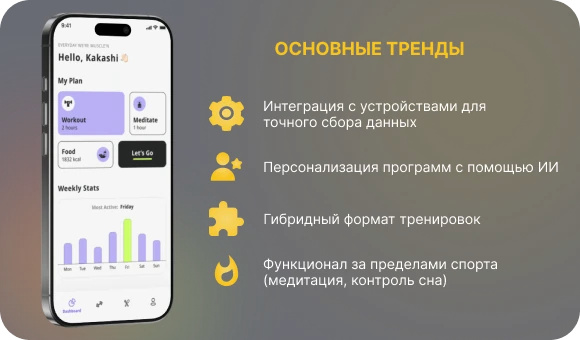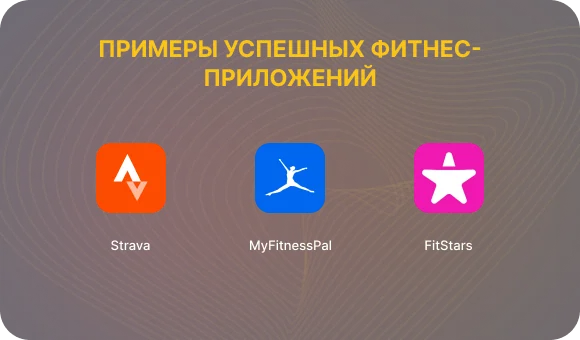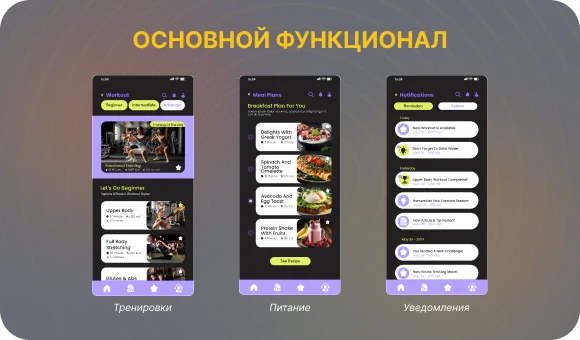Developing a mobile fitness app from scratch
Mobile development apps for fitness from scratch
From generation to generation, interest in a healthy lifestyle is becoming more noticeable: if earlier sports and nutrition control were for enthusiasts, today they have become a familiar part of life for millions of people, facilitated by digital technologies and the availability of information.
The period of the COVID-19 pandemic was a turning point for the fitness industry. Private gyms and restrictions on live classes have prompted millions of people to find online tools to keep fit, and companies to develop such solutions. Video tutorials, streaming platforms and fitness apps have ceased to be temporary replacements and have become entrenched as a full-fledged service or supplement to traditional training. Many users have switched to a hybrid format: they combine trips to the gym with app training at home or outside.
Today's fitness app is a mobile training and recovery tool available to the user 24/7: personal plans and video tutorials, exercise and activity tracking, food diary, reminders, motivation and community, integration with gadgets for accurate data. Therefore, developing a fitness app is becoming a strategic step for companies that want to give users a clear path to their goal and carve out a niche in a growing market.
What is shaping the fitness market today
What is shaping the fitness market today
Figures confirm the context: over the past three years, the global online fitness market has grown by almost 60%, and in Russia, in 2024, users' spending on fitness apps and digital services in this area reached about 5 billion rubles, which confirms the rapidly growing demand for such solutions. The growth is influenced by digitalization, the mass distribution of smartwatches and fitness trackers, as well as the development of AI, which makes recommendations personalized. In such an environment, developing a mobile fitness app becomes a way to enter a fast-growing market with a product that can hold the audience's attention.
The main trends are:
- integration with wearable devices for accurate data collection;
- personalization of programs using AI and development based on behavioral data;
- hybrid training format — a combination of offline classes with on-demand content in apps;
- expanding functionality beyond sports: meditation, sleep and nutrition control.

From beginners to healthy lifestyle enthusiasts: who needs fitness apps and why
From beginners to healthy lifestyle enthusiasts: who needs fitness apps and why
The target audience of fitness apps is diverse — from first-time visitors to professional trainers and biohackers who monitor all aspects of physical health. Developing such solutions requires understanding the goals of each group, their tasks and expectations from the service.
- Newcomers
They take their first steps in training at home or in the gym, look for programs with simple exercises, step-by-step video tutorials and motivation. For this audience, development should include an intuitive interface, gamification (badges, challenges, rewards for activity), and community support through chats and forums.
- Experienced sports fans
They need advanced analytics (distances, speed, heart rate zones), integration with Garmin or Apple Watch devices, personalized goal-oriented plans, and competitive features. During the development process, it is important to take into account their need for accurate data and tools to compare progress, such as Strava with track segments, hobby clubs and global rankings.
- Industry professionals
Trainers and fitness clubs use apps for distance training, progress analytics, subscription management, and communication with customers. This audience focuses on providing high-quality services, so they need special solutions that the development team must consider. The success of FitStars shows that such services can be a full-fledged online coaching platform.

- Health-oriented
They control nutrition, sleep, stress levels, and are interested in yoga and meditation. When developing apps for this audience, it is important to provide food diaries, water trackers, recipes and other features for comprehensive condition monitoring and achieving goals. MyFitnessPal attracts them with a database of 19 million products and a handy scanner. Popular solutions are where you can train, relax and track your habits in one place.
The development of mobile applications for the fitness industry requires taking into account the interests of all segments, combining sports, health and motivation in a single solution.
The strongest players in the fitness industry online
The strongest players in the fitness industry online
Strava. Launched in 2009 as a GPS tracker for cyclists, Strava has grown into a global social network for athletes, with 135 million users in 190 countries today. The development of the project was initially focused on gamification and competitive elements — the trademark is segments and ratings, where you can compete for the championship with other users. The freemium model, advanced analytics and live tracking make it a benchmark for runners and cyclists, and Strava data is even used in urban planning.
Nike Run Club/Nike Training Club. Nike has long gone beyond sports equipment: tens of millions of people use NRC and NTC. Here, development was carried out with an emphasis on integrating with the brand's ecosystem and creating apps that stimulate regular training. During the pandemic, Nike launched premium content for free, doubling activity. Integration with Apple Watch and the brand's ecosystem turns these apps into a powerful loyalty tool.
MyFitnessPal. Founded in 2005, the app has become a global leader in nutrition tracking with an audience of over 200 million users. A convenient barcode scanner, macronutrient goals and integration with other services have made the project a must-have for those who monitor nutrition.
Fitbit. One of the pioneers of wearable trackers, selling more than 100 million devices. The app syncs with bracelets and watches, tracking steps, sleep, heart rate and calories. 38 million active users every week, strong positions in corporate wellness. It has been part of Google since 2021, but the brand is still recognizable.
FitStars. The leader of home fitness in Russia and the CIS. Launched in 2017, the service took off during the pandemic, offering training in Russian without equipment. Local content, affordable pricing, and active influence marketing ensured success, while audience retention was due to the constant updating of courses and the support of trainers in the app. This project was an example of how to create popular products at the request of the local market.

Features that make a fitness app competitive
Features that make a fitness app competitive
The user — whether novice or pro — expects the app to immediately provide all the necessary functionality for training and tracking progress. There is a set of key features without which the product will not work on the market, and there are advanced features that add value to the service and help you stand out from the competition. When planning a project, it is important to take all this into account, and this approach gives businesses the opportunity to increase user loyalty and increase their time of engagement in the service.
Basic features
- Registration and profile: entering data (height, weight, goals) to personalize recommendations.
- Workouts: plans, video and audio instructions, execution tracking.
- Meals: food diary, calorie calculator and BJU, water balance accounting.
- Notifications: training reminders and motivational messages.
- Integration with gadgets: Apple Watch, Fitbit, Garmin, GPS tracking
Advanced features
- Artificial intelligence: automatic generation of plans, analysis of progress, adaptation of loads.
- Social features: chat rooms, clubs, challenges, social media sharing.
- Gamification: badges, levels, leaderboards.
- Educational content: tips from trainers, articles, exercise collections.
- AR/VR modules: visualization of movements and execution techniques in augmented reality, which makes it possible to safely learn the technique even at home.
Developing unique mobile fitness apps requires thoughtful design, easy navigation and reliable protection of personal data (including compliance with GDPR requirements) so that each feature meets the user's real goals.

Developing a fitness app: step by step
Developing a fitness app: step by step
To make a fitness application convenient and popular, development goes through several stages. Every step counts — from initial ideas to post-release updates.
1. Research and planning
First, the team finds out what future users need: they conduct surveys, study reviews of similar apps, and analyze competitors. On this basis, they create screen prototypes (wireframes — schematic layouts) and determine the minimum set of functions with which it is possible to enter the market in the MVP format, the minimum viable product. Such an analysis makes it possible to take into account the requirements and expectations of the audience in advance, as well as lay the foundation for a successful project.
2. Design
Designers develop the appearance and logic of the application (UI/UX): they select colors, fonts, icons, and make navigation simple and understandable. The interface should look good on different devices, from smartphones to tablets and web versions, and allow users to quickly find the features they need and save time.
3. Development
At this stage, the design turns into a working application. Front-end developers are responsible for everything a person sees and uses: the appearance of the application, buttons, menus, animations. The backend developer is engaged in internal “stuffing”: he writes the logic that processes the data, saves it on the server and connects the application to other services. At this stage, key features are added: training and nutrition tracking, integration with gadgets and payment systems, as well as AI algorithms for personal recommendations.

4. Testing
Before launching, the application is tested on different devices and under different conditions. Functional testing ensures that all sections work as intended, load testing ensures that the application can withstand a large number of users, and cross-platform testing ensures that the interface appears correctly on iOS, Android and the web, and, if necessary, allows you to develop improvements for different platforms.
5. Launch and support
The application is uploaded to the App Store and Google Play, and if necessary, a web version is made. After launch, the team continues to support and develop the project: it collects feedback, fixes bugs, adds new features and updates content: training sessions, articles, and improved AI algorithms.
This path allows you to create projects that grow with the audience and remain useful for years. This is how we develop specialized mobile apps for fitness — with attention to detail at every stage.
How do fitness apps make money and how are they promoted
How do fitness apps make money and how are they promoted
In order for a fitness app to be not only useful but also profitable, it is important to consider how the company will make money on it, as well as how to attract and retain users.
Popular monetization models:
- Freemium — basic features are free, and a premium subscription offers advanced features: no ads, exclusive plans, additional metrics.
- Subscription — monthly or annual billing (often with a free trial). The average price is $5-10 per month.
- advertisement — built-in but unobtrusive ads, for example, from sports brands or food manufacturers.
- Paid content — individual courses, training plans or coach consultations that can be purchased within the app.

Marketing and promotion:
- SEO — optimizing the site and content for queries like “fitness app” and articles about physical health, nutrition and training.
- Social media — Instagram, TikTok and YouTube for posting training videos, challenges and collaborations with influencers.
- User retention — push notifications with reminders, loyalty programs, discounts on subscriptions or partner products.
For example: Strava uses a freemium subscription model, and Nike Run Club is betting on free branded content, strengthening the connection with users through the Nike ecosystem.
Conclusion
The fitness app market is growing, competition is increasing, and users are expecting more convenience and benefits from services. To stand out, it's important not just to have an idea, but to implement it correctly: from research and design to launch and promotion. We know how to turn a concept into a product that keeps you focused, motivates you to train and makes a profit.
If you want to create a fitness app that will be in demand on the market and meets your business goals, start with a free consultation with our experts. Together, we'll find a strategy and functionality to make your app a hit.










